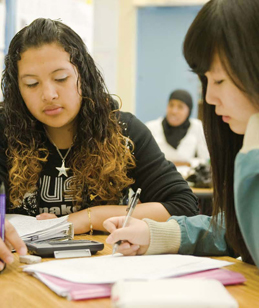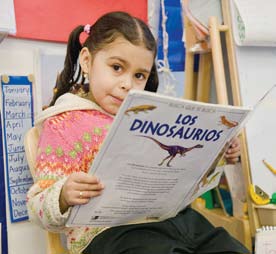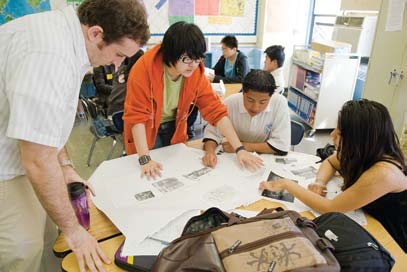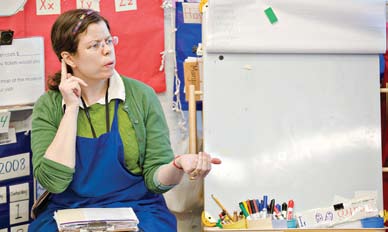Calling a Rose by Its Other Names
Around the world, the consensus is that bilingualism is a strength. It’s time the
At Flushing International High School in Queens, Humanities teacher Kevin Hesseltine recently kicked off a class on imperialism by scribbling the following direction on the blackboard: “Free Write: Has your native country experienced Imperialism? By who? Was it economic, political, social or all of the above? Give examples.”
At a table of ninth and tenth graders, one boy, whose family had recently emigrated from
“Was your country ever invaded,” explained a girl from
“Yes,” the boy replied. “
He then called out, in Chinese, to several other Chinese boys, who suggested—in English—another possible invader:
And so it goes at Flushing International and its sister schools (eight in
“Their language is a part of who they are as people, not just as learners,” says Principal Joseph Luft. “You don’t deny students a part of who they are or prevent them from using skills and abilities they have to learn. If someone sent you and me off to
Rising Tide
The number of
Yet according to data from the National Assessment of Educational Progress (NAEP), only 4 percent of these “English language learners” in the eighth grade are proficient in reading and only 6 percent in math. Seventy-one percent of ELLs scored below “basic” on the eighth grade NAEP reading and math tests. ELLs trail English-proficient students by 39 points in reading and 36 points in math on a 500-point scale nationally. And a survey in 2003 revealed that 50 percent of ELLs fail their graduation tests, compared with 24 percent of English-proficient students.
To TC faculty members Ofelia García and Jo Anne Kleifgen and doctoral student Lorraine Falchi, authors of the Equity Matters research review “From English Language Learners to Emergent Bilinguals,” those failures stem from a fundamentally close-minded approach to language—and one that is very much at odds with mainstream thinking in other countries. In fact, while it may seem counter-intuitive, research has shown that using a child’s first language is the most effective way to help her achieve a higher level in an English language school system. “The benefits of such practices are explained by the concept of linguistic interdependence—the notion that two languages bolster each other and the student’s ability to acquire knowledge,” the TC authors write.
That’s very much the thinking—and practice—at the Twenty-First Century Academy for Community Leadership, a predominantly Hispanic pre-k–8 school located in
“We have signs to go with all of our routines, so the children become more comfortable with them,” says Blachley who hit upon the sign language idea with a fellow teacher. “I don’t have a scientific article to prove it, but I see them able to produce more language.”
And where bilingual children at most
To Ofelia García—a native Spaniard who, despite her multiple degrees and her flawless English, says she still sometimes feels intimidated walking into American schools—this is merely common-sense thinking.
“Throughout the world, bilingualism is the norm,” says García, who heads TC’s Center for Multiple Languages and Literacies. “But here, bilingualism is the elephant in the room. In viewing non-native speakers simply as people who ‘don’t yet speak English’ we’re focusing only on the elephant’s tail.”
Paradigm Shift
It wasn’t always that way. In the 1960s, the Bilingual Education Act established a federal goal of assisting limited English speaking students in the quick acquisition of English. In the early 1970s, in Lau v. Nichols, a group of Chinese-American parents brought a judicial case against the San Francisco school board that eventually went before the U.S. Supreme Court, successfully arguing that, by being thrown into English-only classrooms, ELLs were being (in the words of the Court’s majority opinion) “effectively foreclosed from any meaningful education.” The Court instructed school districts to take “affirmative steps” to address these inequities, but left the mode of instruction up to the educators.
Things began to change in the 1980s, when the focus of the Bilingual Education Act began to shift toward supporting programs that used only English in educating ELLs and that imposed time limits on participation in transitional bilingual education. In the 1990s, the use of children’s native language to support learning came under political siege, perhaps best typified by Proposition 227, a
García, Kleifgen and Falchi believe that these policy shifts have amounted to a “silencing of bilingualism and bilingual education.” They argue that the very term “English language learner” reflects all the failings in the
At
Published Tuesday, May. 20, 2008




